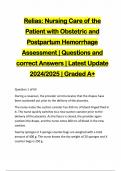Exam (elaborations)
Test Bank for Advanced Practice Nursing Essentials for Role Development 4th Edition by Lucille A. Joel , ISBN: 9780803660441 |COMPLETE TEST BANK| Guide A+
- Course
- Advanced Practice Nursing
- Institution
- Chamberlain College Of Nursing
CONTENTS: UNIT 1 THE EVOLUTION OF ADVANCED PRACTICE Chapter 1 Advanced Practice Nursing: Doing What Has to Be Done Chapter 2 Emerging Roles of the Advanced Practice Nurse Chapter 3 Role Development: A Theoretical Perspective Chapter 4 Educational Preparation of Advanced Practice Nurses: Looking to ...
[Show more]












